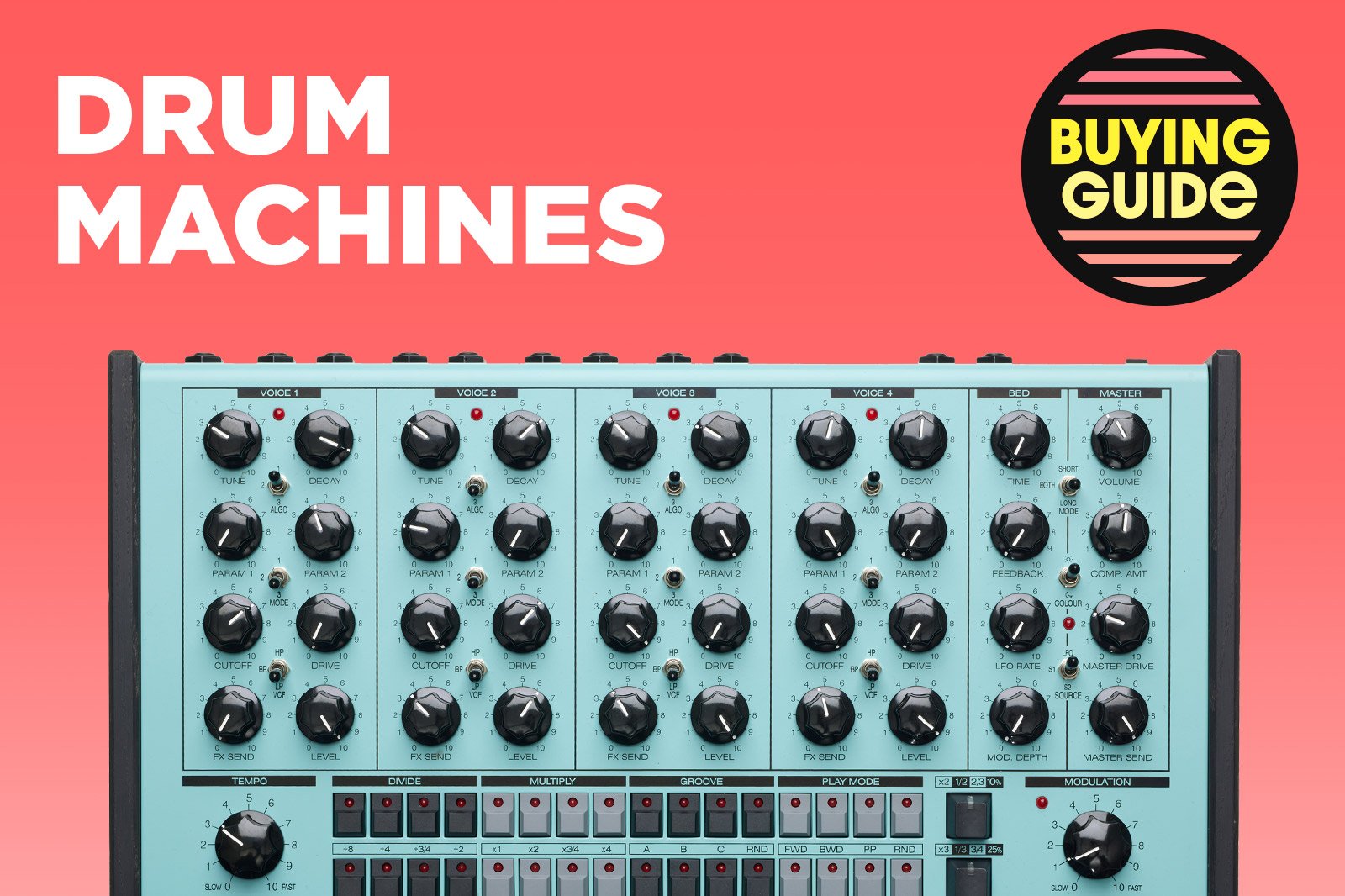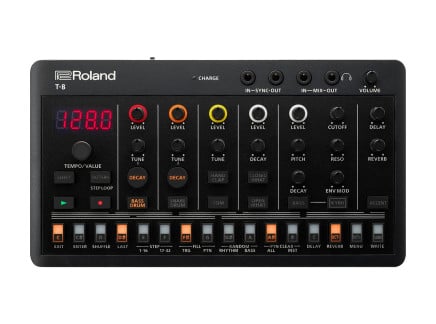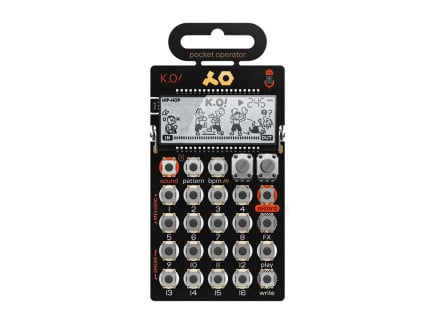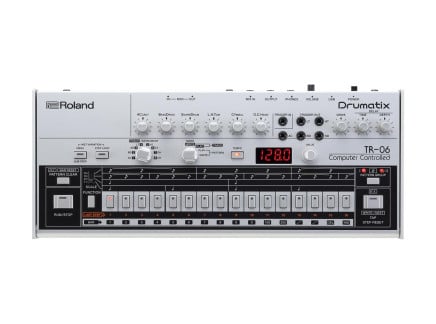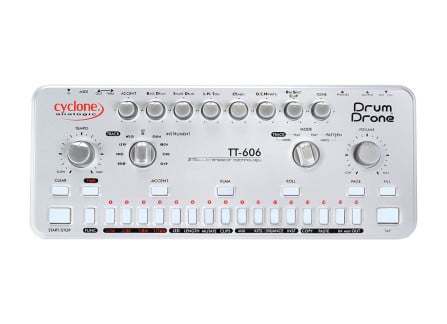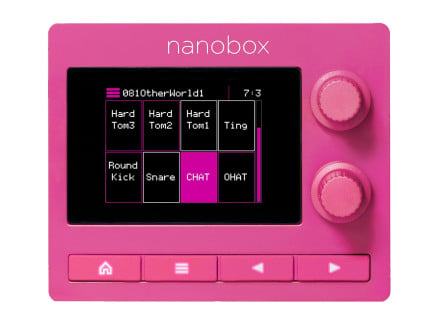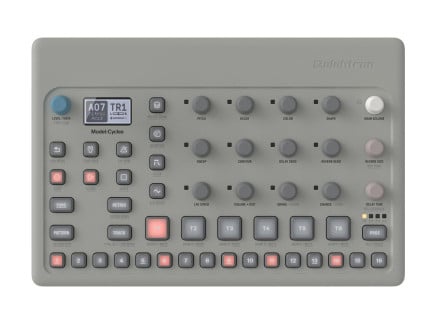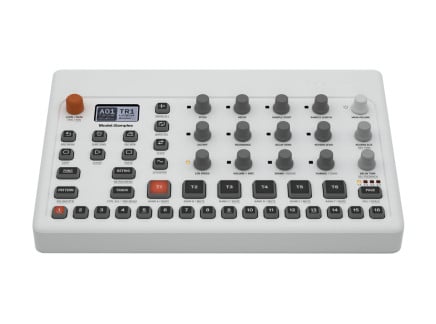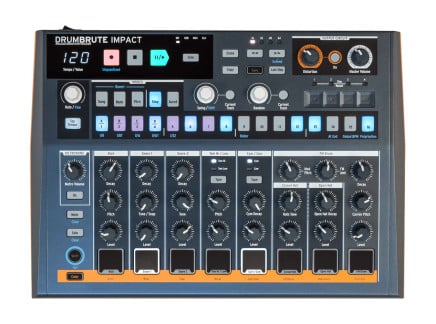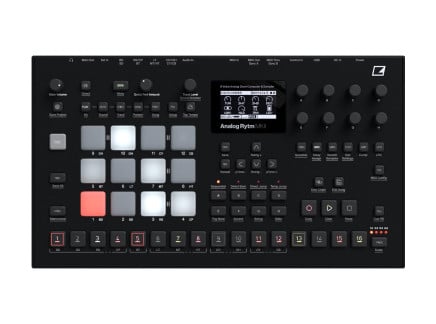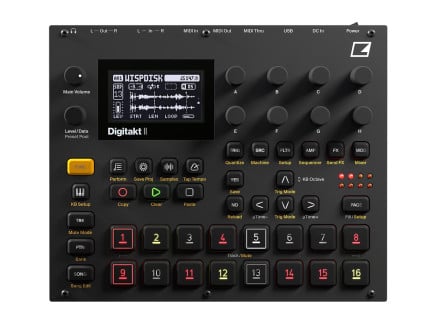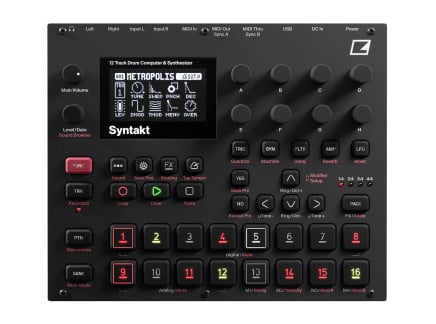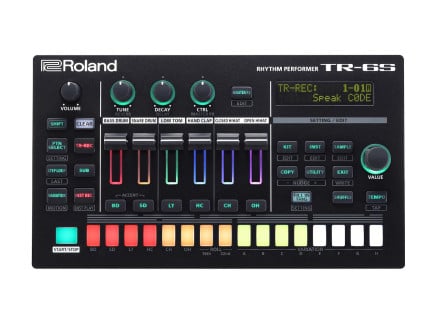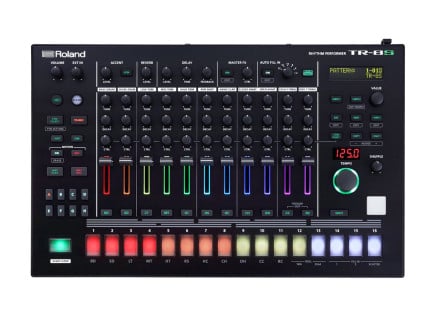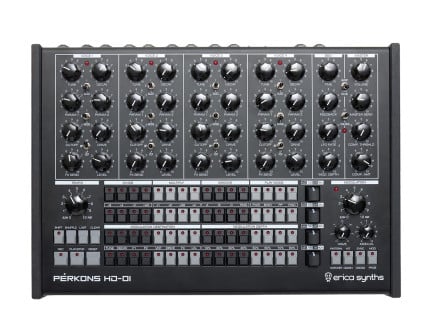Since the adoption of classic devices like the Roland TR-808, Oberheim DMX, Linndrum, and Akai MPC-60, it's become clear: drum machines can easily become the backbone of not only specific pieces of music, but of entire genres of music. But drum machines are much more than computers for creating musical rhythms in the studio: many are also fully-featured performance instruments that, in the right hands, can create sounds that no one has ever heard.
As technology has advanced, these machines' possibilities have expanded exponentially. Today, the drum machine market is full of options, ranging from simple, straightforward emulations of classic devices all the way to forward-thinking, no-holds-barred devices for creating the music of the future. In this article, we're going to break down some of our favorite currently-available drum machines, with plenty of musical examples along the way.
For the purposes of this article, we're only discussing devices with built-in sequencing and, for the most part, are not discussing samplers/all-in-one production workstations like the modern MPC series. Instead, we're focusing in on devices aimed explicitly toward the creation of rhythm...though as we'll see, many are capable of creating compelling full arrangements on their own.
We have a lot of ground to cover—and as such, this article is broken into themed sections with a few of our favorite recommendations in multiple product categories. Specifically, we'll discuss budget-conscious devices, affordable instruments based on vintage drum machines, and affordable devices with a more modern approach to beat-making. From there, we'll move on to higher-end instruments, including some of the best drum machines available altogether, as well as some devices that take a peculiar new approach to the creation of rhythm-oriented music. Ready to dive in? Read on.
Budget-Conscious Beat Machines (Under $200)
Let's start by taking a look at the most affordable end of the spectrum: drum machines designed to get folks into the world of electronic music hardware without breaking the bank. Luckily, these days there are tons of options for budget-friendly beat machines—so let's look at some options from Roland, Korg, and Teenage Engineering in particular.
Roland's Aira Compact series brings powerful music making equipment to an affordable, battery-powered form factor…and the T-8 is the beatmaker extraordinaire in this line-up.
Inspired by the 606, 808, and 909, the Aria Compact T-8 uses proprietary Analog Circuit Behavior technology, letting you get those vintage tones without all the large, vintage components. Program up to 32 steps for each of the voices—bass drum, snare, tom, clap, open and closed hi hats—plus a bass synth for adding some tasty riffs. This little buddy is effortlessly playable thanks to the Step Repeat function, and you can store up to 64 patterns for quick access on the fly.
Easy to use and great for performance en plein air, the Aira Compact T-8 has great features, like beat and bass randomization, as well as a built in delay and reverb. There are no hidden menus and everything accessible is labeled clearly, taking the guesswork out of making a beat so you can just focus on making tunes. Straightforward with a massive sound (seriously, the bass drum is outstanding), the Aria Compact T-8 can get a pattern going quickly, so you can leave plenty of room for inspiration.
You can't mention budget or portable drum machines without talking about the Korg Volca series. Aside from their incredible synth-centric options, such as the Volca Keys, Volca FM, or Volca Modular units, Korg's line of affordable instruments offers four different types of rhythm machine options—each with their own timbral options and at a price that lets you scoop up a couple to try.
Volca Drum is a physical modeling synthesizer that lets you customize six different percussive sounds in any way you want. There is no bass, snare, or hi hat specific sound, which is what makes this unique: you can have a kit of all toms, wooden tones, or just a fully customized traditional kit all based on unique synthesized sounds.
If you're looking for sample based beats, the Volca Sample 2 is a perfect option for making unique sounds. While it doesn't have a huge memory, that is part of its charm: how creative can you be with limitations? The Sample 2 does have a robust set of knobs for adjusting start time, pitch, and an Analogue Isolator to fine tune the EQ of your samples.
Aside from these somewhat more modern offerings, the Volca series also offers a couple of more vintage-inspired designs. The Volca Kick is a fun percussive addition because it can be just a kick or clicks or generate tones, too. Based on the classic MS-20 filter, the Kick is all analog giving you nice warmth as well as musical saturation. Rounding out the Volca lineup is the Volca Beats, another analog drum machine that is more of a traditional setup with dedicated sound sources for bass drum, snare, and hi hats. All of these are great options for generating percussive patterns and it's best to try out each one and see what suits your needs.
Teenage Engineering is popular for their exquisite OP-1, but they have really made their mark with the Pocket Operators. These handheld, battery-powered rhythm machines come in several different flavors that give you specific types of drum sounds or tonal sequence options. One of the most popular ones is the PO-33 K.O.!, which has lo-fi sampling capabilities, pattern chaining, and time stretching. Handy for quick samples and has playable monetary effects for beat repeat, reverse, and others, this is a versatile pick for creating beats.
No matter which Pocket Operator you get, though—and perhaps you should grip a few—you can generate some unique patterns and have fun doing it.
Affordable Vintage-Inspired Drum Machines (Under $500)
Sometimes, it's hard to beat the sound of a tried-and-true classic drum machine—maybe an 808 kit is just what your track needs! But even though the original vintage units become more expensive on the used market year after year, you don't have to pay astronomical prices for getting those same sounds in your hands today.
Of all musical instrument manufacturers, few have put out as many legendary drum machines as Roland. The TR-606 and TR-808 each command an impressive legacy, to the point where entire genres of music owe their existence to the sounds of those machines. Today, those same kits can be found in Roland's Boutique series, with the TR-06 and TR-08 respectively carrying the torches of the 606 and 808 into the future, with plenty of modern updates for contemporary music studios.
Digital at their core, the entire Boutique line employs Roland's Analog Circuit Behavior (ACB) technology to deliver accurate sounds and behavior, thanks to not just emulating the sonic character of the originals but ingenious modeling of their circuits down to the component level. After all, no one knows these instruments better than Roland themselves, so it would only make sense that these digital descendants hold their own against the originals. As for the sequencing, the original workflows remain intact if you're already familiar with how these drum machines work. That said, Roland took the chance to sneak in some additional functions like rolls, ratchets, real-time tap programming, and more.
The TR-06 and TR-08 both provide shrunken-down versions of the original interfaces, but still pack in new features and conveniences to make them seamless additions to your studio. There's MIDI I/O (which the originals did not even have), USB connectivity, battery-powered portability, and, for the TR-06, built-in effects. In many ways, Roland's Boutique line realizes the ideal versions of their most famous instruments, and we think that the TR-06 and TR-08 are no exception.
But, if analog is the only way for you to go, Cyclone Analogic has been producing updated takes on Roland's classic instruments and drum machines. With a lineup that also includes the acid-y TT-303 Bass Bot, Cyclone offers the TT-606 Drum Drone and TT-78 Beat Bot as their rhythm-savvy boxes.
As you might guess from its name and appearance, the TT-606 Drum Drone is Cyclone's version of the TR-606. While it does look a lot like the 606, this Drum Drone features a streamlined sequencer workflow and modern features like MIDI In and Out ports plus individual audio outputs for the drum voices. These additional outputs are not only handy for multi-tracking, but you can also try running certain tracks through pedals or other effects processors to find wider sound palettes. Compared to the original, the TT-606 sequencer is way more straightforward to use so you're bound to get programming in beats immediately.
Cyclone's other drum machine is the TT-78 Beat Bot, which is actually based on one of Roland's earlier percussion instruments: the CR-78. But unlike the original, which was essentially a big box with pre-programmed rhythms and limited capacity for custom patterns, Cyclone's version is housed in a 606-like package and offers the same sort of workflow as the TT-606. As such, the TT-78 is probably one of the most unique takes on the CR-78 out there, short of just loading up a sampler with one-shot samples of the original. In fact, if you're looking for a 606-style workflow but want a different sound set to work with, we can't think of a better choice than the TT-78.
Affordable, Forward-Thinking Drum Machines (Under $500)
Of course, the sounds of vintage drum machines aren't necessarily appropriate for every musical situation. You might instead be looking for something new: and luckily, there are plenty of options out there. In this section of the article, we're going to discuss instruments that offer decidedly more modern approaches to sound design and sequencing while still falling in a sub-$500 price point.
Elektron makes exceptional professional equipment for composing with samples and sequencing complex rhythmic patterns. This can come at a price, but if you want to get into the Elektron line, but start off slowly, the Model:Cycles and Model:Samples are the groove boxes you are looking for.
Model:Cycles is an FM synth at its core with voices that are tuned for creating percussive sounds, but it's also great at generating melodic lines. Since it utilizes FM, that means digital bliss is just a few button presses away, and everything from harsh noise and metallic blasts to wooden, snappy sounds are easily programmed. Their Tonal and Chord options are great for adding melodic lines and each of the six tracks has all their options spread across independent knobs making it very easy to adjust.
Model:Samples utilizes the same form factor, but uses samples instead of a synth engine to generate its sounds. This means you can get more complex sounds and unique flavors with the 1GB of internal memory and 64MB sample size, freely open for you to load up. Complete with reverb and delay sends on either the Cycles or Samples, dry driving kits are just as easy to make as blissed-out reverb-soaked kits. Both units can send their audio over USB and can function as a 6 track MIDI sequencer making both these versatile and budget friendly options.
Expanding their nanobox series, 1010 Music brings us their razzmatazz, a compact, vibrant drum machine that packs a whole lot into a little. Loaded with a fine variety of kicks and presets, you can also record directly into it, load in your own samples, and adjust them to fit the sonic tableau that you're creating. Those who have used their other nanoboxes or blackbox will be at home with the sequencer page, and even if you haven't, it's intuitive and easy to use, thanks to their crisp touch screen.
Each preset gives you 8 tracks of percussion and each of those has a plethora of customizability options from filter, to pitch, to effects. You can also craft full sets with the option to store 16 patterns per preset. If you need a compact way to make beats with a quick workflow, the 1010 Music nanobox | razzmatazz is the bright raspberry-colored friend for you.
If you want budget analog drum sounds, look no further than the DrumBrute Impact from Arturia. Featuring 10 analog sounds for bass, snare, clap, hats, toms, FM sounds, and more, the DrumBrute is a marvel when it comes to making big, gnarly drum sounds. Each pattern can have up to 64 steps and with 8-voice polyphony, it can take what you throw at it. The eight pads are velocity sensitive allowing you to dynamically record your perfect pattern.
For complex routing, combine with a mixer and use the individual outputs for the bass, snare, hi hats, and FM drum to add separate effects and EQ—allowing for immense sound design potential. The DrumBrute Impact plays well with others by using 3.5mm Clock sync, 5-pin MIDI I/O, and USB connectivity so you can slip into whatever your workflow is with ease. Designed to sound great and get you making patterns in no time, Arturia's DrumBrute Impact is the perfect option if you want analog sound in a modern package without typical analog price.
Best In Class: Our No-Holds-Barred Favorites
Maybe you've been around the block a few times with some other drum machines and you're looking to step up to a new box. Or perhaps you're a sound designer at heart and jive with a flexible sequencer that brings your sounds to life. In either case, or a myriad of other scenarios, you might crave the premium drum machine experience. These next instruments on our list represent the pinnacle of the drum machines in our catalog, and any of them would be a great choice for creating top-level tracks and performances.
No conversation on powerful drum machines would be complete without mentioning Elektron, and in fact, we'll be mentioning them a few times in the following paragraphs.
Representing their flagship Analog line, the Analog Rytm is a powerhouse hybrid drum machine that melds heavyweight analog synthesis with sample layering for rich and highly personalized sounds. Its 12 tracks can control eight analog voice circuits with incredible precision and versatility, ranging from heavy-hitting kicks to all sorts of metallic cymbals and strange impulses. Add in analog filters and onboard effects like delay, reverb, and compression, and it quickly becomes apparent that Analog Rytm is one of the most sonically complete drum machines ever conceived.
Of course, Rytm owes much of its power to the Elektron sequencer workflow, through which its sound architecture is cracked wide open for your wildest percussive needs. The flexibility is astounding—each track can have its own independent length and time division of the global tempo, and each step can address all of the most vital sound parameters for instant recall on a per-step basis. Through other features like Kits and Song Mode, you can lay out intricate arrangements and swap in different sounds for your patterns as necessary.
The Analog Rytm is obviously positioned to be an incredible instrument for performance, but it is equally comfortable at home in your studio, too. With Elektron's Overbridge software and your Rytm connected to your computer via USB, you gain access to both plugin-style user interfaces for tweaking parameters and the ability to stream individual audio tracks into your DAW of choice. Or if you're sketching ideas on the go, class-compliant USB audio allows you to record directly to your phone or tablet, or even sample videos and sounds from your phone into the Rytm.
But of course, Elektron has also seen incredible success with their Digi line, which is positioned as a sort of intermediate level between the Model series on one end and the Analog instruments plus Octatrack on the other. But that said, Elektron cut very few corners in designing these instruments, and through continued firmware development over the years they have added more features that bring them ever closer to the capabilities of their flagships. The Digi experience as a whole is streamlined—complex data structures are largely overhauled in favor of simplicity, and any given parameter is usually no more than a few button presses away.
Digitakt kicked off the Digi party a few years ago and has continued to be a hallmark of the Elektron catalog. It's a drum-oriented sampler with an impressive eight audio tracks, which of course may be blasted open through Elektron sequencer tricks to change parameters and even samples on a per-step basis.
And like the Analog Rytm, you can make use of class-compliant USB audio to sample any sound from your computer, phone, or tablet into the Digitakt, so you're never limited to just the sounds and instruments physically around you. But Digitakt also serves as a powerful eight-track MIDI sequencer, meaning that any other instruments in your studio or live rig can benefit from having an Elektron sequencer on hand. And now with the release of Digitakt II, this instrument has gotten even deeper and more powerful: with stereo sampling, new approaches to timestretching and pitch mangling, more storage, new filter machines, and more—it's easily one of the greatest samplers of all time.
If you prefer drum synthesis over sampling, then you might rather try Elektron's Syntakt. As a 12-track hybrid drum machine comprising both analog and digital synthesis methods, and extends well beyond the capabilities of a typical drum machine. Sure, there are plenty of kicks, snares, and other drum sounds to explore, but load up the Dual VCO or Chord machines and you'll find melodies, basses, and pads hiding within Syntakt. The inclusion of a global FX track is also a unique feature for Syntakt, where you can create sub-mix groups of both internal tracks and external audio sources to be processed by the global analog filter and VCA, as well as delay and reverb.
We've already mentioned Roland's history of producing legendary drum machines, and how their Boutique line captures the individual magic of their legacy instruments. But what if you wanted every classic Roland and the ability to mix and match 606, 808, and 909 sounds with each other and your own sounds? Well, that happens to be exactly what the TR-8S is all about, on top of also providing a highly immediate and performance-friendly interface.
Like the Boutiques, the TR-8S utilizes Roland's ACB technology to realize digital recreations of the original circuits. But the TR-8S gathered up the entirety of the TR family, offering the 606, 707, 727, 808, and 909, along with select modified versions of each, too. But this isn't an instrument that's stuck living in the past—Roland also packed in a powerful FM drum synthesis engine, and the ability to load in your own custom samples with an SD card. This sonic flexibility combined with the classic TR-x0x sequencer approach makes the TR-8S a truly compelling instrument with a tried-and-true interface.
But even with a more traditional sequencer layout, Roland packed in plenty of ways to give your tracks a modern flair. You can certainly program in steps the old-fashioned way, but there are also live playing and recording options. Dial in polyrhythms or polymeters by individually changing track lengths, enter in flams or ratchets with sub steps, or use probability, pattern variations, and fills to give your sets some dynamic sensibility. And that's not even mentioning the immediate access to essential track parameters and built-in effects, which themselves can be used to elevate your music.
Equally comfortable on stage and in the studio, TR-8S is also equipped with plenty of hardware and software points of connectivity to make its integration into your life even more seamless. All eight tracks have individual outputs for external processing and mixing, and external audio can be routed into the TR-8S for immediate blending with its sounds. Its also a powerful USB audio and MIDI interface, with multi-track recording and full MIDI implementation for modulation and automation. Simply put, it's clear that Roland was taking notes on what other drum machines were bringing to the table. As such, the TR-8S is both a culmination of every famous Roland drum machine that came before it and a powerful platform for pushing electronic drums into the future.
It's also worth note that the TR-6S offers many of the features of the TR-8S in a reduced package and a lower price point...well under $500.
The Weird Stuff: Drum Machines from Another Planet
The Jomox Alpha Base MkII takes the legendary legacy of Jomox drum machines to new heights, refining its analog and sample-based synthesis into a powerful, intuitive drum machine. Building on the iconic features of previous models like the XBASE 09 and MBrane, the Alpha Base MkII combines the best of Jomox's drum synthesis and sample playback into a single, highly playable unit.
With 11 instruments at your disposal, the Alpha Base MkII covers all the essential electronic percussion sounds, from deep analog kicks to intricate cymbals and snares. It uses true analog circuitry for its kicks, bass drums, and Jomox's signature MBrane voice, ensuring a punchy, organic sound. For the rest of your drum kit, the Alpha Base blends analog filtering with sample playback, offering everything from hi-hats and claps to crash and ride cymbals, providing a versatile toolkit for a wide range of genres.
The Alpha Base MkII doesn’t just stop at drum sounds; it also includes two user-defined sample playback instruments, allowing you to import your own sounds or sample external audio directly into the machine. For even more sonic possibilities, the six-voice FM synth engine gives you the option to craft more melodic and complex textures, adding a new layer of creativity to your beats.
Sequencing is a breeze with the onboard step sequencer, while MIDI I/O and USB connectivity make integration with other gear and DAWs seamless. Whether you're sequencing internal sounds, using the Alpha Base as a MIDI controller, or sampling external audio, this drum machine has the flexibility to fit into any workflow. The Alpha Base MkII is the definitive version of Jomox's iconic drum machine, offering an expansive set of features, incredible sound quality, and the versatility to suit any modern music producer's needs. Whether you’re looking for punchy analog percussion, complex sample manipulation, or FM synthesis, the Alpha Base MkII delivers it all in one cohesive and powerful package.
And then, there's the Soma Laboratory Pulsar-23…and frankly, nothing about Pulsar-23 is ordinary.
Created by Vlad Kreimer, Pulsar-23 is easily one of the strangest and most powerful electronic percussion instruments to ever exist. The idiosyncrasies of the machine, however, don't come at the expense of usability or functionality. This drum synthesizer was created by the designer by following their own intuitions and original ideas instead of attempting to replicate or even modify any previously existing design. And as such, it's wholly unique.
Above all, Pulsar-23 is a modular instrument with a wide range of possibilities. However, it does not religiously conform to any conventional patching format. Instead, its interface is densely populated with ambiguous binding posts for alligator clips. This seemingly odd decision, in reality, has a number of practical and creative advantages. First, as was mentioned by Vlad Kreimer himself, it allowed Soma to increase the total number of patch points on the instrument without making it more expensive, or significantly larger. Secondly, it exposed a variety of unusual performance and sound design possibilities. For example, gestural modulation of clusters of parameters using one's body as a patch cable or densely entangled feedback networks is a breeze on Pulsar-23. Moreso, the obscurity of the design actually increases its capacity to musically mingle with instruments of any format. Alligator clips on their own are quite adaptable for interfacing with many things, however, for the sake of convenience, Pulsar-23 includes built-in 8-point 1/8", and 6-point 1/4" bi-directional converters. On top of that, it includes a fully-equipped MIDI-to-CV module.
In terms of its sonic arsenal, Pulsar-23 sports 4 distinctly different from each other percussion voices labeled BD (bass drum), Bass, SD (snare drum), and HHT (hi-hat). While the names of the voices are quite straightforward, their practical applications far exceed conventional expectations, and all are quite capable of tonal, and textural sounds. Other modules include 4 two-stage envelopes, a Clock with an integrated array of dividers, a variable-waveform LFO, a special pseudo-random generator called Shaos, a modulate-able digital effects processor, a distortion, three pairs of VCAs, voltage inverters, and switches, and many more additional modules and functions for transforming audio and modulation signals—a playground for sonic expression…a happy place.
Now, Soma describes the instrument, quite specifically as an organismic drum machine. And although four MIDI and CV-controllable unique percussion synth voices surrounded by utilities, modulators, and effects are more than enough to make up a seriously fun instrument, it takes a bit more to make it truly organismic. A good drum machine is so much better with a sequencer. In many instances, a sequencer may very well be a defining factor for the way a drum machine feels and sounds. Soma offers an ingenious solution by equipping each voice Pulsar-23 not with a standard step-sequencer, but with a dedicated tape-style phrase looper. The sequences are not programmed but recorded with physical gestures, and this element adds a sort of natural fluidness to the rhythms while keeping the workflow with the instrument playful at all times.
Esoteric by nature, Pulsar-23 is truly an instrument like no other that invites a musician to develop an intricately personal approach to it. More than a drum synth, it is a wildly flexible canvas, beaming with a seemingly infinite array of possibilities for radical sonic experimentation. Available in both its origina form and in the more affordable "screw version," the Pulsar-23 is a wild and inspiring instrument.
Last on our list of oddities, and named after a Baltic god of thunder, Erica's Pērkons HD-01 is a drum and drone machine that truly lives up to its deemed ground-shattering potential. Comprised of four hybrid analog-digital voices, a nuanced sequencer, a flexible modulation LFO, a digitally modeled bucket brigade delay, a master compressor, and a wealth of performance features, the instrument is tailored toward intuitive live interaction, and unobstructed music making. Erica Synth intentionally put an emphasis on the simplicity of the interface when designing the device, making it such that all of the necessary functions are always one or two button presses away. Deep menu dives that can significantly halt the creative flow are skillfully avoided without sacrificing the complexity where it is needed.
Pērkons's four voice engines are distinct from each other, yet all feature a digital sound engine with 3 selectable algorithms, 3 selectable algorithm modes (variations), and an analog multi-mode filter. The sound engines sport a variety of approaches to sound synthesis, including wavetables, waveshaping, FM, and Karplus-Strong.
There is no hard-lined separation between the types of sounds you would assign each voice to, but as a general rule, the first voice is best suited for kicks, voice 2 for toms, bass, and melodic synth sounds, voice 3 for snares, toms, and hits, and voice 4 for hi-hats, noise, and cymbal-type sounds. Each voice features a set of 8 identical parameters: Tune, Decay, Param 1, Param 2 (functions vary based on the algorithm), Cutoff, Drive, FX Send, and Level. As indicated earlier Pērkons is not only a drum machine but also a characterful texture synthesizer. Turning the Decay knob on a given voice fully clockwise makes it drone, and given that the instrument offers individual analog outputs per voice, one can easily imagine a scenario with all four sounds being individually routed through a set of external effects.
The way the sequencer is implemented on the instrument is also quite ingenious. Unlike striving for an extended step count—a trend observed in many contemporary instruments—Erica judiciously downshifts to the bare 16 steps. This allows a performer to fully focus on what is happening in front of them, without having to scroll through pages. Moreso, Erica compensates for the decreased step count by offering advanced alternative features for enhancing musical complexity. These include set-per-track sequence length, clock division/multiplication, play modes, groove, shuffle, direction, step probability, and ratcheting. Moreover, every single parameter on the machine can be modulated via a free-running or tempo-synced LFO, freeform motion recording, or precise parameter locking.
As a whole, Pērkons is an extraordinary percussion instrument. Its quite distinct yet hugely varied sonic character paired with uncommonly intuitive workflow encourage play and spontaneity that can be very addictive, and keep one energized to pull off a lengthy performance with nothing but this machine alone. In fact, Pērkons gives out a strong vibe that this is exactly what it was designed for—to keep you focused on making music, inspired and undistracted.
Honorable Mentions
Of course, whittling our list of favorite drum machines down to a single article was quite a task—and it left a lot of important instruments unmentioned. I'd like to point out a couple in particular.
Modor's DR-2 is an oddity in the same ballpark as the Pulsar-23 and Alpha Base—a six-part, digital drum machine with a 128-step sequencer. Its 15 "models" allow you to create a wide range of bass drum, snare drum, cymbal, clap, tom, and miscellaneous percussion sounds, each with twelve variable controls, allowing a tremendous amount of sonic flexibility. Additionally, it features dedicated inserts for every voice...making it possible to create direct-out mixes or to add external processing for each individual voice. DR-2's sounds aren't made to emulate anything that preceded it—and as such, it has a sound all its own.
And of course, there's more—from Novation's Circuit series to countless samplers, drum synthesizers, and electronic drum pads. We hope that this article has left you with some inspiration, or some ideas of how you might invite a new drum machine into your life—and of course, if you're still looking for more information, feel free to reach out to talk about what drum machine might be right for you.

